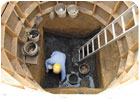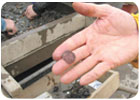
Archaeologist Carter Hudgins excavates the well.
In Jamestown, Va., historic Jamestowne archaeologists have discovered a virtual time capsule of environmental and cultural data sealed inside an enormous well that may have been built by Capt. John Smith nearly 400 years ago, according to Dr. William Kelso, director of archaeology for the APVA Preservation Virginia.
Kelso says plants, wild and domestic seeds, pollen, parasites, insects and food remains survive in wells below the water-table because of the oxygen-deprived atmosphere. “There is no other source for this kind of environmental data in such a preserved state, so precisely documented in time. It has the potential to tell us much about the environment in Virginia and the Chesapeake Bay region when Smith and other Englishmen established Jamestown in 1607,” Kelso says.
He notes that the watery environment also can preserve paper, leather, pewter, wood, fabric and other materials that decay more quickly in dry environments. “These objects are rarely found on sites this old, and the sheer volume of material that we will recover is going to be enormous. This well is more than four times the size of other wells that we've excavated from this time period. It's about 6 feet square and probably about 20 feet deep,” he says.

Krauwinkel jetton found in the well shows no signs of rust due to the well's oxygen-starved environment.
Discovered last fall inside a corner of the fort site, the well was hidden beneath the brick ruins of a fireplace in a 1617 addition to the first Virginia governor's house originally built in 1611. “After they abandoned the well, the colonists filled it with trash and then built over it, sealing everything inside it. But we know it is much earlier than 1617, and it may be the well built in 1608 or 1609 that Smith describes in his journal,” he says.
Currently, archaeologists are excavating just below the water table inside the well about 12 feet beneath the 17th-century ground level. The well has an intact wooden box that lines the shaft below the water level. The box is aligned with the fort wall and other fort structures. Kelso says a number of men with mining experience were in Jamestown at the time the well was built, which may explain the box-like construction technique. He thinks the well may extend as much as 10 feet more into the water table. It also is as far away from the river as possible and still inside the fort walls.
Kelso said they plan to excavate the well about one day a week to allow time for the staff to process the artifacts. The public is encouraged to watch as objects are unearthed, and nearby video monitors will enable them to see down into the well. They also can observe as dirt is screened for artifacts.
Because of the delicate nature of the objects submerged beneath the water table, a team of specialist consultants including micro-botanical specialists and entomologists will assist the staff in the recovery and analysis. Excavation will be completed in 2006, but the analysis will continue into at least 2007.


Report Abusive Comment